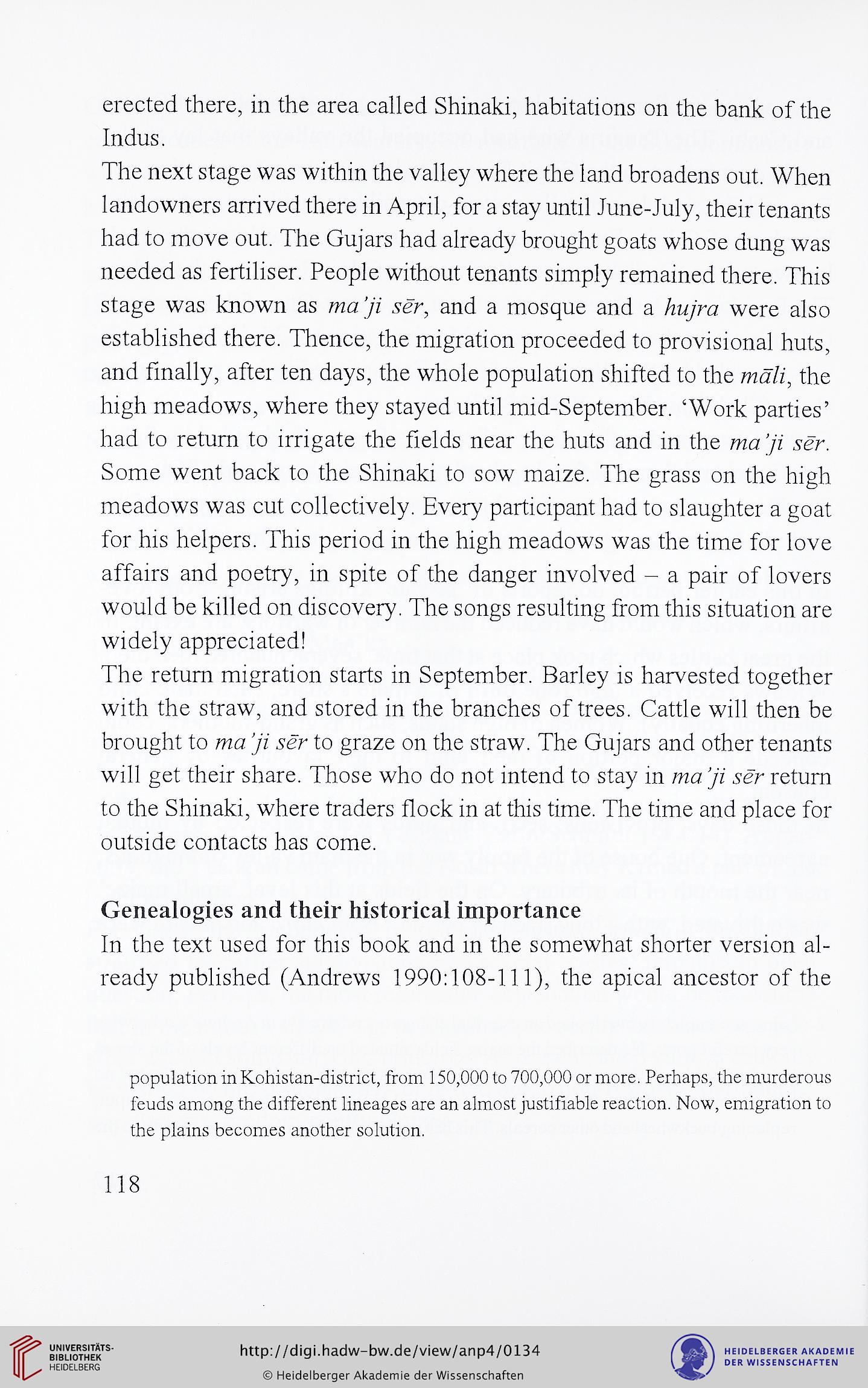erected there, in the area called Shinaki, habitations on the bank of the
Indus.
The next stage was within the valley where the land broadens out. When
landowners arrived there in April, for a stay until June-July, their tenants
had to move out. The Gujars had already brought goats whose dung was
needed as fertiliser. People without tenants simply remained there. This
stage was known as muyz and a mosque and a /zzz/hu were also
established there. Thence, the migration proceeded to provisional huts,
and finally, after ten days, the whole population shifted to the mu/z, the
high meadows, where they stayed until mid-September. 'Work parties'
had to return to irrigate the fields near the huts and in the mu yz
Some went back to the Shinaki to sow maize. The grass on the high
meadows was cut collectively. Every participant had to slaughter a goat
for his helpers. This period in the high meadows was the time for love
affairs and poetry, in spite of the danger involved - a pair of lovers
would be killed on discovery. The songs resulting from this situation are
widely appreciated!
The return migration starts m September. Barley is harvested together
with the straw, and stored m the branches of trees. Cattle will then be
brought to mu yz to graze on the straw. The Gujars and other tenants
will get their share. Those who do not intend to stay m z?zu yz Am return
to the Shinaki, where traders flock m at this time. The time and place for
outside contacts has come.
Genealogies and their historical importance
In the text used for this book and in the somewhat shorter version al-
ready published (Andrews 1990:108-111), the apical ancestor of the
population in Kohistan-district, from 150,000 to 700,000 or more. Perhaps, the murderous
feuds among the different lineages are an almost justifiable reaction. Now, emigration to
the plains becomes another solution.
118
Indus.
The next stage was within the valley where the land broadens out. When
landowners arrived there in April, for a stay until June-July, their tenants
had to move out. The Gujars had already brought goats whose dung was
needed as fertiliser. People without tenants simply remained there. This
stage was known as muyz and a mosque and a /zzz/hu were also
established there. Thence, the migration proceeded to provisional huts,
and finally, after ten days, the whole population shifted to the mu/z, the
high meadows, where they stayed until mid-September. 'Work parties'
had to return to irrigate the fields near the huts and in the mu yz
Some went back to the Shinaki to sow maize. The grass on the high
meadows was cut collectively. Every participant had to slaughter a goat
for his helpers. This period in the high meadows was the time for love
affairs and poetry, in spite of the danger involved - a pair of lovers
would be killed on discovery. The songs resulting from this situation are
widely appreciated!
The return migration starts m September. Barley is harvested together
with the straw, and stored m the branches of trees. Cattle will then be
brought to mu yz to graze on the straw. The Gujars and other tenants
will get their share. Those who do not intend to stay m z?zu yz Am return
to the Shinaki, where traders flock m at this time. The time and place for
outside contacts has come.
Genealogies and their historical importance
In the text used for this book and in the somewhat shorter version al-
ready published (Andrews 1990:108-111), the apical ancestor of the
population in Kohistan-district, from 150,000 to 700,000 or more. Perhaps, the murderous
feuds among the different lineages are an almost justifiable reaction. Now, emigration to
the plains becomes another solution.
118




